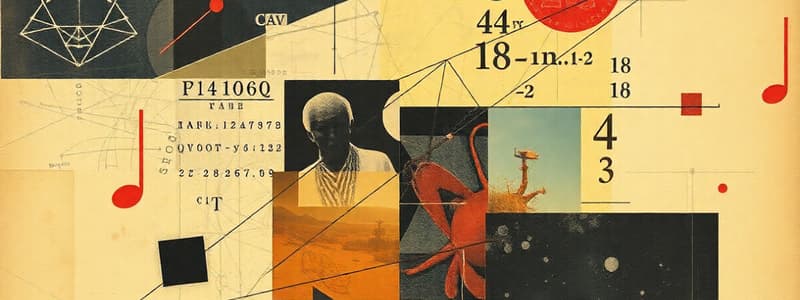Podcast
Questions and Answers
In the context of statistics, what differentiates descriptive statistics from inferential statistics?
In the context of statistics, what differentiates descriptive statistics from inferential statistics?
- Descriptive statistics uses samples to make predictions about populations, while inferential statistics summarizes data sets.
- Descriptive statistics focuses on predicting future trends, while inferential statistics summarizes existing data.
- Descriptive statistics deals with qualitative data, while inferential statistics deals with quantitative data.
- Descriptive statistics summarizes data sets, while inferential statistics uses samples to make predictions about populations. (correct)
How does number theory contribute to the field of cryptography?
How does number theory contribute to the field of cryptography?
- By offering methods for secure data transmission using properties of prime numbers. (correct)
- By creating complex data structures for storing encrypted information.
- By providing algorithms for data compression.
- By developing statistical models for predicting data breaches.
What is the primary focus of discrete mathematics, and where are its applications most commonly found?
What is the primary focus of discrete mathematics, and where are its applications most commonly found?
- Limits and derivatives; calculus.
- Statistical modeling; economics.
- Distinct and separate objects; computer science. (correct)
- Continuous functions; physics.
Within probability theory, how are probability distributions utilized?
Within probability theory, how are probability distributions utilized?
What role do recursion and combinatorics play within discrete mathematics?
What role do recursion and combinatorics play within discrete mathematics?
Which of the following best exemplifies the application of the distributive property in simplifying an algebraic expression?
Which of the following best exemplifies the application of the distributive property in simplifying an algebraic expression?
Considering the principles of coordinate geometry, how would you determine if two lines on a coordinate plane are perpendicular?
Considering the principles of coordinate geometry, how would you determine if two lines on a coordinate plane are perpendicular?
In calculus, what does the derivative of a function at a specific point represent?
In calculus, what does the derivative of a function at a specific point represent?
How does understanding place value contribute to performing multi-digit arithmetic operations, such as multiplication?
How does understanding place value contribute to performing multi-digit arithmetic operations, such as multiplication?
Which statement accurately describes the relationship between differential and integral calculus?
Which statement accurately describes the relationship between differential and integral calculus?
In number theory, what is the significance of prime factorization in determining the greatest common divisor (GCD) of two numbers?
In number theory, what is the significance of prime factorization in determining the greatest common divisor (GCD) of two numbers?
How do variables in algebra enable the generalization of arithmetic operations?
How do variables in algebra enable the generalization of arithmetic operations?
What is the relationship between congruence and similarity in geometric shapes?
What is the relationship between congruence and similarity in geometric shapes?
Flashcards
Prime Number Algorithms
Prime Number Algorithms
Techniques used to identify prime numbers, crucial in number theory.
Descriptive Statistics
Descriptive Statistics
Methods that summarize and organize data sets for analysis.
Inferential Statistics
Inferential Statistics
Uses samples to make generalizations about a larger population.
Discrete Mathematics
Discrete Mathematics
Signup and view all the flashcards
Probability Distributions
Probability Distributions
Signup and view all the flashcards
Mathematics
Mathematics
Signup and view all the flashcards
Arithmetic
Arithmetic
Signup and view all the flashcards
Place Value
Place Value
Signup and view all the flashcards
Algebra
Algebra
Signup and view all the flashcards
Geometry
Geometry
Signup and view all the flashcards
Calculus
Calculus
Signup and view all the flashcards
Number Theory
Number Theory
Signup and view all the flashcards
Differential Calculus
Differential Calculus
Signup and view all the flashcards
Study Notes
Fundamental Concepts
- Mathematics is a fundamental field of study, dealing with logic, quantity, and structure.
- It encompasses a wide range of subjects, from basic arithmetic to complex calculus and beyond.
- Core branches include algebra, geometry, calculus, and number theory.
- Mathematics plays a crucial role in numerous scientific disciplines, engineering, and everyday life.
- It involves the study of abstract concepts.
- Concepts are often supported or demonstrated by examples or proof.
Arithmetic
- Arithmetic is the fundamental branch of mathematics dealing with numbers.
- It includes operations such as addition, subtraction, multiplication, and division.
- Understanding place value is essential for performing arithmetic operations.
- Different systems of numeration (e.g., decimal, binary) exist.
- Properties of operations (e.g., commutative, associative, distributive) are critical to simplifying calculations.
- Algorithms for handling larger numbers or complex operations (e.g., long division) are important.
Algebra
- Algebra expands on arithmetic, introducing variables and equations.
- Variables represent unknown quantities, allowing for general solutions to problems.
- Equations express relationships between variables.
- Solving equations involves manipulating them to isolate variables.
- Algebraic manipulations utilize principles like addition, subtraction, multiplication, and division, and also concepts like factoring and rational expressions.
- Polynomials, quadratics, and other algebraic structures are essential tools in many applications.
Geometry
- Geometry focuses on shapes, sizes, and their properties.
- Different types of shapes exist like polygons (triangles, squares, etc.), circles, and three-dimensional objects.
- Concepts of congruent and similar figures are key.
- Geometry involves measuring angles, lengths, and areas of shapes in two and three dimensions.
- Theorems like Pythagoras' Theorem relate geometric concepts.
- Coordinate geometry positions shapes in a plane using coordinate systems.
Calculus
- Calculus deals with continuous change.
- Differential calculus studies rates of change and slopes of curves.
- Differential equations relate rates of change to the quantity itself.
- Integral calculus deals with accumulating quantities over an interval.
- Applications extend to physics, engineering, computer science, and more.
Number Theory
- Number theory investigates properties of integers.
- Divisibility, prime numbers, and factorization are central topics.
- Algorithms for finding prime numbers play an important role.
- Properties of integer sequences and series are studied.
- Number theory has significant applications in cryptography.
Statistics and Probability
- Statistics uses data and methods to draw conclusions.
- Probability examines the likelihood of events.
- Descriptive statistics summarize sets of data.
- Inferential statistics uses samples to make predictions about populations.
- Probability distributions describe the likelihood of outcomes in experiments or models.
Discrete Maths
- Discrete mathematics deals with objects that are distinct and separate.
- Key topics include sets, logic, counting methods, graph theory, and finite structures.
- Applications are prevalent in computer science.
- Recursion and combinatorics are common tools.
Studying That Suits You
Use AI to generate personalized quizzes and flashcards to suit your learning preferences.




